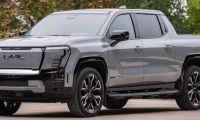If I was writing any kind of commonplace review of the little Ford Fiesta, I would give the economy car generally high praise for its spunk and feisty vigor. For its economy, too. But this is a forum for news, and only my experience with the new-concept, PowerShift transmission in the 2011 Fiesta elevates to the level of news.
The transmission came close enough to failing me that its one-time performance warrants this transmission-only report.
The Fiesta is a world-concept car introduced in the United States by Ford in mid 2010 as a 2011 model. The starter model, with a list price of $13,995, comes with a 120-horsepower four-cylinder engine and five-speed manual transmission. For an additional $1,070, you can get the six-speed PowerShift automatic that Ford heralds as a “North American industry exclusive.”
Original press material describing the six-speed automatic promises “the responsive performance of a manual shift with the convenience of a traditional automatic.”
“Fiesta’s PowerShift transmission gives better fuel efficiency than a traditional torque convertor automatic or manual shift transmission,” a Ford press release announced. It quoted Barb Samardzich, vice president of Ford global powertrain engineering, as saying “PowerShift is a transmission that changes the game. Our fuel economy leader is now a PowerShift automatic. Traditionally, a small car driver needed a stick shift and a clutch pedal to enjoy the greatest fuel efficiency.”
I won't argue with that. Driving a PowerShift Fiesta for a journalist's standard field evaluation – one week of treating the test model like it's your everyday transporter – I averaged a fraction over 37 miles per gallon over 350 miles of around-town driving. The official EPA fuel-economy estimates come in at 29 mpg city, 38 mpg highway, so I did very well.
(With a manual transmission, Fiesta drops one mpg in both city and highway ratings. You can purchase a Super Fuel Economy package for $2,765 above Fiesta's base price, boosting the EPA rating to 29/40, an industry high among sub-compact cars, according to the EPA's Fuel Economy Guide.)
After a half year in service in the United States, any problems with Ford's first PowerShift application here should have surfaced by now. But temperature is one big variable that suddenly has changed since Fiesta's introduction. Where I live in the frozen northeast, out first encounter with icy temperatures occurred while I was test driving the still-new Ford. Even with today's electronic engine and transmission controls, a car starting on a frozen morning must run through a choke cycle till it reaches normal operating temperatures.
The first frozen morning I started my test-model Fiesta, the car barely made it off of the parking pad. The engine stuttered and gurgled and felt like it was about to stall – like an old-time, carbureted engine that a driver floods by pushing off too quickly. My impulse was to declutch and feather the accelerator to bring up the engine RPMs. But of course, the PowerShift is an automatic. It has no clutch pedal. All I could do was let the engine and transmission controllers catch up and work out the problem.
Most of my anxiety over shifting occurred during the cold-start cycle. But at times, even when the car was fully warmed, the transmission seemed confused about what gear to select. That was especially true when I made partial-load demands on the auto, as when holding a steady, moderate speed while climbing a hill near my home. In such cases, my impression wasn't so much that the transmission was searching. More accurately it seemed stuck, and simply stayed in an inappropriate gear from confusion – until finally the controller worked out the algorithms.
I contacted Ford several times via e-mail, asking if the company had received any complaints or was otherwise aware of cold-weather issues with the Fiesta PowerShift transmission. I received no response. Therefore the issue stands, at least for now, as one car writer's questionable experience.












Comments
Powershift
Permalink
The shifting problem may not be cold weather related. Our Fiesta was delivered in July. From the start, the Powershift transmission had trouble selecting the right gear--especially at low speeds or on inclines.
Ford replaced it with a new unit. The new one has been behaving fairly well, but your report would indicate that Ford hasn't completely debugged their transmission or their public relations machine.
ford fiesta powershift trans problems
Permalink
I too have an issue with the 2011 fiestas powershift trans. We bought this car in sept 10 and didn't really have the shifting problems others are reporting with theirs. If you think about it, it will be natural for a six speed auto to "search" for the right gear at times as it will be more responsive to throttle changes. My problem was something i have noticed, but as yet my wife hasn't. And I think it is a good thing for ford, that she never finds out because she is a consumer that will not tolerate products that make noise or that do not function properly, and will probably return this vehicle to them over this.. Honda found that out as a purchase of a 2006 CR-V went foul for them, after a simple rear washer bottle problem, turned into the car being classed as a lemon. The dealer had it more than we did, and six 70 mile trips to the dealer later, and she sued them, returned the vehicle to them and traded it in on a 2008, that was eventually traded on the fiesta. I KNOW that as soon as she experiences this there is going to be trouble. I am sure ford has already heard from owners on this but is possibly a design flaw that surly will not be tolerated by owners when explained to them by the company or your dealer. The problem i noticed is a cold weather thing now that we have experienced our first snowfall. Other owners with the auto trans can also try this i am sure with the same results. Your "auto" trans is ACTUALLY two 3 speed manual transmissions being electronically shifted by alternately by the cars computer, in direct relation to throttle position. One trans covers 1,3 and 5th, the other takes care of 2,4, and 6th and they shift back and forth as it goes through the gears, this is why the shifting of your car sounds as tho it is a manual, because it IS a manual. This is where the problem comes in here, as the trans needs the wheels to be rolling constantly in order to shift up AND down properly. On a slippery road surface covered by ice, if you lock up the wheels and slide on the ice you will hear a noise that sounds to me like lug nuts being rolled around in a hubcap as the trans attempts to downshift without the axles turning! This is very unnerving for ME to say the least, let alone when this happens to YOUR WIFE! I will schedule a service call and put this to the dealer and report back on what they tell me
I just recently had a
Permalink
I just recently had a catastrophic failure of the powershift transmission in my 2011 fiesta i took delivery of it last week and after only 200 miles the transmission completely failed on me. first it hung in between 1st and second and "free revved" before dropping hard into gear then when I tried to back it out of my parking spot for lunch I discovered that reverse was no longer working either, I am USAF stationed in England and the weather isn't bad here right now its been mid 70's with almost daily rain (was dry the day the trans went) it is currently in an independent auto center that handles ford and other US manufacturer warranties for new US spec vehicles in this area, I am interested to see what they find wrong with it since Ford seems to be trying to keep things under wraps by convincing customers that they are imagining these problems or just replacing the transmissions. This makes me think there may be a serious design flaw, or programming issue that will cost them a fortune to fix, hence why they're dodging it for now. Shoulda got a 5 speed, needless to say my confidence in my brand new car is completely shattered and I am scared to take my family on long trips with it or let my wife drive it for fear she may break down somewhere, this is NOT why I bought a brand new car!! If I had've known this was going to happen I would've just bought something used, but now I'm stuck with it, thanks Ford. I'll never buy a Ford product again.
I've been driving the Ford
Permalink
I've been driving the Ford Fiesta equipped with the Powershift Tranny for 6 months now. I've been experiencing hard upshifts and downshifts when travelling in slow moving traffic. During low speed inclines, I realized that the Powershift is not selecting the right gears and the trottle response is lagging. This lead me to accelerate harder thus causing the car to suddenly downshift and too much power is being produced to move the car forward. The Powershift has a problem with selecting the right gear and also the right trottle response since the car is equipped with fly by wire technology. I've send in my car to the dealer many times to complain about the problem and they keep telling me that everything is fine with the tranny and it is a matter of time of getting used to it.
What nonsense. I'm from Malaysia and all the Fiesta owners here is experiencing the same problem.
Hi. I'm from Mexico and I
Permalink
Hi.
I'm from Mexico and I haven't tried my MT fiesta 2011 under such frozen conditions, but I do happen to work in a zone filled with steepy hills and let me tell you, all that fuel eficency and horse power that Ford show off all the time about this car are null under those conditions, even with the engine fully warmed.
Mine is currently with my dealer, and they are trying to figure out if its one of a kind type of problem, but today I found out that another car with similar problems was submitted recently.
Only time will tell...
Well my Ford Fiesta had less
Permalink
Well my Ford Fiesta had less then 1800 miles on it when the transmission started chattering while holding a steady traffic speed of 30 MPH after it warmed up. Now it does it bad between 30 and 55 MPH, still after it is warmed up. It’s nine with its cold. Also twice after putting 2900 miles on the car, the transmission would not release when trying to stop at a stop light. It drove me through a red light, TWICE. It was as if I was driving a manual transmission car and forgot to put the clutch in. Scared me to death, but I am forced to keep driving it. Took it to Kline Motors, a Ford dealership in Winfield KS. They said they worked on it for 2 hours and charged me over $175 and did absolutely NOTHING except tell me the transmission need replaced for $5200. For 2 hours work they did not even up-date the computer that drives the transmission. I bet they mechanic never even touched it. Ford will not cover it because the car was in a very minor fender bender and the title was marked rebuilder. What a cop out. What ticks me off about Kline’s is I told them I re-built the car, which was nothing more than a front bumper cover and AC lines for the most part and all the parts were OEM parts. I asked Kline’s to check the VIN to make sure Ford would cover it and they said it would still be covered to 36,000 miles. Why the car was flagged by the insurance company I have no idea, but Ford is sure using it as an excuse not to touch it.
In any case I got a piece of crap Ford Fiesta that I am scared to death to drive but for now am stuck with it every day, and every day wondering if it’s going to drive me through another intersection to get hit by someone. If I was Ford I would be scared to death with these cars on the road. This should be a safety issue and the NTSB should force them to make a re-call on them for safety reasons.
So, does anyone have any ideas on what parts I need to replace to fix this transmission? I sure can’t afford a new one at $5200. That is crazy.
ford has a tsb out right now,
Permalink
In reply to Well my Ford Fiesta had less by Tim (not verified)
ford has a tsb out right now, which is on its way to possibly being a recall for replacing the dual clutch and seals, ive replaced 3 in the past year, its not a major problem but is fairly expensive repair, id suggest taking it to a different dealer to see if its the dealer feeding you some shit, in my many years of working for ford ive never seen then deny a warrant claim UNLESS it can be directly pointed that it was caused by wreck or customer
This is utterly outrageous,
Permalink
This is utterly outrageous, and it's not just Ford that's guilty.
Sadly, a number of 'quality' carmakers are now jumping on the dual-clutch transmission bandwagon in an effort to keep abreast of emissions regulations by maximising fuel economy and reducing emissions with the least short-term investment into alternative technologies.
But by trying to keep up with each other in an increasingly competitive marketplace, the manufacturers are all following each other up a blind alley, and this DSG fiasco will come back to bite them all real hard.
Actually, it already is. Ford's PowerShift, Audi's S-Tronic and VW's DSG transmissions are all proving to be a disaster for their owners. And looking at the recalls, repairs and replacements that continue to take place, the manufacturers must be feeling the pressure by now.
It's true that the twin clutch transmission looks impressive on paper. But would I have one on my driveway? Not a chance. I want to know that my car will start, engage gear and drive me to where I need to go, whatever the weather. Most cars will do that most of the time - provided they don't have a DSG 'box. Regrettably, it seems that the DSG is the best way to ensure you never get anywhere on time, if at all.
And I strongly object to Ford, VW or whoever using their customers as guinea pigs, effectively using the public's money to test their unreliable gimmicks before the manufacturers are sure their new toys will actually do what they claim.
I think the CVT probably has greater potential for development as a more reliable and economical alternative, but is probably being sidelined by the manufacturers because of the perceived uncharacteristic driving experience with past incarnations. However, I believe these transmissions are coming of age, and having recently driven Nissans' latest incarnation of their own CVT technology I have to say that I was impressed.
As for the the DSG and its derivatives -- avoid them like the plague.
Hi, We in Indonesia gets the
Permalink
Hi,
We in Indonesia gets the Powershift for the 1.6L Fiesta model. Its from Thailand.
The Powershift gearbox logic is what I rather call PowerSHIT.....ha ha ha.
I regretted I bought the Powershift but the 1.6L is only available with PowerSHIT.
What other posters said are true. Sometimes the gearbox gets stupid and confused what gear to choose.
What I hate most are these conditions :
Small car parks. Decently steep climb due to space shortage.
A climb that needs a car to enter at 90 degrees turn and then another 90 degrees turn to exit the climb, typical in a small car park situation. Before we can turn or even allow the forward part of the car to join the next floor car park,we got to stop to see possible traffic.
I have learnt to choose L and can't use D in this condition.
Use D and the gearbox will get confused when climbing. As another poster wrote, light pressure on accelerator pedal will cause gear to up shift to 2nd gear but the climb can't be done with 2nd gear, there is not enough torque. So we press harder on the accelerator, car goes into 1st gear and jumped forward and I am about to join the next floor carpark.....got to brake. This sequence will cause the gearbox to jerk and make that stupid gear change noise because it is confused.
OK, problem solved most of the time with L setting for above.
Next car park. Very long uphill climb. Use L. This car park requires me to stop at near the top to look out for traffic which will be coming down and do a 90 degrees left turn too. So I creep slowly and not brake to a dead stop. Upon reaching near the top, car has lost forward momentum due to the need to slow down.
Here is what I hate, even in L mode, the car can not detect a climbing situation. Oddly it has the climb assist which means it has a inclino meter , but will only work when car do a complete dead stop. So trying to climb near the top of the climb, the Powershift balancing the cluth against engine RPM ..........but unfortunately it chooses lowest RPM possible ( polite and smooth gear change ) and the engine vibrated heavily wanting to die from the load applied by the car climbing. I feel like a beginner negotiating a climb on a manual gearbox.....hahaha. In a manual gearbox, I would increase RPM and slip the clutch a bit to gain torque from the engine, but not the PowerSHIT.
It seems PowerSHIT sense the RPM drop and then compensate.....but its just to slow and let the engine vibrated like a bloody newbie driver doing a slope climb.
The car ECU indeed is adaptive. It has learn my aggresive driving. It is not so stupid as it initially was for throttle sensitivity on flat road. I am now only at 2,700 km. However, on traffic of 15-20km/h , it sometime still gets confused on the gear to choose, even at the most light touch of the accelerator pedal, this is D mode.
The clutch release from zero speed to a moving speed is simply too slow even at L mode.
I would assume L mode will be allowed more agressive clutch slip to get better acceleration, but no.
This make a 1.6L 120HP Ford Fiesta PowerSHIT slower than its Mazda 2 cousin with 1.5 liter 100HP engine for 0-100 and manual transmission. 75kg heavier the Fiesta is and with extra 20HP and still slower...that is shitty engineering.
So if Ford said all the benefits of a manual transmission and auto in one package called Powershift, it is not true. I bought this car un-tested. I took in good faith Ford and Getrag the gearbox maker are good brands.
I will swap for a 5 speed manual Fiesta 1.6L when later it is available in my country. I like the Fiesta, I really do. Its just the Powershift is a disappointment. No wonder in UK there is no PowerSHIT option for Fiesta. The Brits knows its not worth having.
For my city where stop and go driving is a "given" way of life. I do not believe Powershift will survive a long time.
And I am not even complaining yet on the defective steering rack we are having now. New car sounds like a 100,000KM car on minor bad road surfaces.
SP
My 2011 fiesta has not gone
Permalink
My 2011 fiesta has not gone into drive, several times! Reverse works but no forward gear. Several times this has happened in heavy traffic and has scared the hell out of me!!